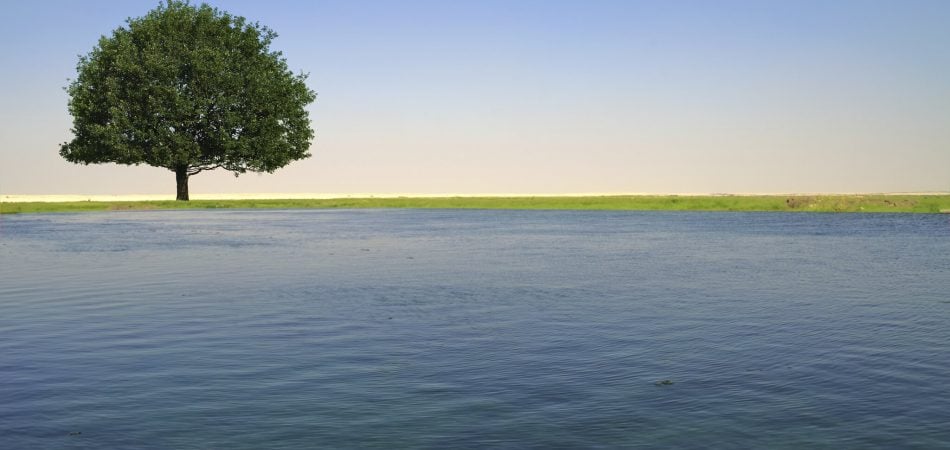
Qatar faces several challenges to its limited and overexploited water resources. These are described in more detail below.
Increasing water demand
Accelerated industrial development coupled with population growth has put pressure on Qatar’s water resources. Over the years, water demand has grown considerably, reaching 1.9 MCM/d in 2019. This number is expected to rise to 2.2 MCM/d in 2022.[1] Qatar also has one of the highest domestic water consumption rates in the world, at approximately 500 L/cap./d.[2] High household water consumption remains a significant problem, and incentives, such as, practical incentives (i.e., rebate or replacement of high efficiency type appliances) are needed to reduce domestic water usage.[3]
Inefficient water use and network loss
The agricultural sector is the main user of groundwater. Agricultural water consumption accounts for 37% to 40% of total water resources from all sources and is used for the production of local crops, which meet only 8% of the national demand for food and fodder.[4] Another challenge is low irrigation efficiency due to traditional irrigation methods.
The current capacity of Qatar’s desalination plants is around 540 MCM/yr. In 2011, around 30% of this volume was lost due to leakage in the water network.[5] [6] To achieve the objective of enhancing water management laid out in the first National Development Strategy (NDS-1), which covered the period 2011-2016, Kahramaa invested in decreasing the rate of water leakage and loss in desalinated water networks. The loss rate dropped to 10% (around 55 MCM) in 2015, of which 4.7% was real losses from leaking and less than 6% was administrative losses.[7] Water loss declined further to 5% in 2017.
Exploitation of groundwater resources
Qatar currently depends on seawater desalination to supply 99% of the municipal water demand, while the industrial and agricultural sectors are dependent on limited groundwater resources, the country’s only freshwater resource. Annual groundwater withdrawal rates are several times the natural recharge rate. The overexploitation of groundwater aquifers is causing a decline in aquifer levels, leading to seawater intrusion and creating the conditions for high vulnerability to groundwater salinization.
Dependence on desalination and lack of water storage
With a lack of sufficient freshwater resources and heavy reliance on desalination, water storage is a major concern. Qatar only has around a 48-hour storage supply of water in case of emergencies.[8] As such, Qatar is investing in potable water storage capacity through the Mega Reservoirs Project. The first phase of the project, which started in 2015, consists of constructing 24 large concrete reservoirs by 2026, providing 8.7 MCM of water storage capacity and seven days of potable water within its network system.[9]
Production of brine
A major challenge associated with desalination technologies is the production of brine, a highly concentrated saline solution. Brine disposal is both costly and associated with negative environmental impacts, such as the detrimental effect on marine flora and fauna.[10] It also causes osmotic pressure changes in marine organism cells, eventually affecting the production and growth of marine organisms.[11] Qatar has a 5.8% share in global brine production. Improved brine management strategies are required to reduce the negative environmental impacts and economic cost of disposal, thereby stimulating further developments in desalination facilities to protect water supplies for current and future generations.[12]
[1] Qatar General Electricity and Water Corporation, n.d. Water Sector.
[2] Mannan M et al., 2019. Examining the life-cycle environmental impacts of desalination: A case study in the State of Qatar. Desalination, 452: 238-246.
[3] Ismail H, 2015. Food and Water Security in Qatar: Part 2 – Water Resources. Global Food and Water Crises Research Programme.
[4] Ministry of Development Planning and Statistics, 2018. Qatar Second National Development Strategy: 2018-2020.
[5] The State of Qatar Second Voluntary National Review, 2018.
[6] Baalousha H M and Ouda O K M, 2017. Domestic water demand challenges in Qatar. Arabian Journal of Geosciences, 10: 537.
[7] Ministry of Development Planning and Statistics, 2018. Qatar Second National Development Strategy: 2018-2020.
[8] Dutch Ministry of Foreign Affairs, 2019. Uniting Water Energy Food NEXUS in Qatar.
[9] Oxford Business Group, 2018. Capacity Increase in Power and Water Utilities Key to Supporting Qatar’s Economic Expansion.
[10] Pérez Talavera J L and Quesada Ruiz J J, 2001. Identification of the mixing processes in brine discharges carried out in Barranco del Toro Beach, south of Gran Canaria (Canary Islands). Desalination, 139(1-3): 277-286.
[11] Belatoui A et al., 2017. Environmental effects of brine discharge from two desalination plants in Algeria (south-western Mediterranean). Desalination and Water Treatment 76: 311-318.
[12] Jones E et al., 2019. The state of desalination and brine production: A global outlook. Science of the Total Environment, 657: 1343-1356.
